Seaplane

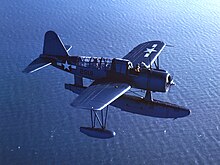
Aseaplaneis a poweredfixed-wing aircraftcapable oftaking offandlanding(alighting) on water.[1]Seaplanes are usually divided into two categories based on their technological characteristics:floatplanesandflying boats;the latter are generally far larger and can carry far more. Seaplanes that can also take off and land on airfields are in a subclass calledamphibious aircraft,or amphibians. Seaplanes were sometimes calledhydroplanes,[2]but currently this term applies instead tomotor-powered watercraftthat use the technique ofhydrodynamic liftto skim the surface of water when running at speed.[1]
The use of seaplanes gradually tapered off after World War II, partially because of the investments in airports during the war but mainly because landplanes were less constrained by weather conditions that could result in sea states being too high to operate seaplanes while landplanes could continue to operate. In the 21st century, seaplanes maintain a few niche uses, such as foraerial firefighting,air transport around archipelagos, and access to undeveloped or roadless areas, some of which have numerous lakes. In British English, seaplane is sometimes used specifically to refer to a floatplane, rather than a flying boat.
Types[edit]
The word "seaplane" is used to describe two types of air/water vehicles: the floatplane and theflying boat.
- Afloatplanehas slender floats, mounted under thefuselage.Two floats are common, but other configurations are possible. Only the floats of a floatplane normally come into contact with water. The fuselage remains above water. Some small land aircraft can be modified to become float planes, and in general, floatplanes are small aircraft. Floatplanes are limited by their inability to handle wave heights typically greater than 12 inches (0.31 m). These floats add to the empty weight of the airplane and to thedrag coefficient,resulting in reduced payload capacity, slower rate of climb, and slower cruise speed.

- In aflying boat,the main source ofbuoyancyis the fuselage, which acts like aship's hullin the water because the fuselage's underside has beenhydrodynamicallyshaped to allow water to flow around it. Most flying boats have small floats mounted on their wings to keep them stable. Not all small seaplanes have been floatplanes, but most large seaplanes have been flying boats, with their great weight supported by theirhulls.
The term "seaplane" is used by some instead of "floatplane". This is the standard British usage.[1][3]This article treats both flying boats[4]and floatplanes[5]as types of seaplane,[6]in the US fashion.
Anamphibious aircraftcan take off and land both on conventionalrunwaysand water. A true seaplane can only take off and land on water. There are amphibious flying boats and amphibious floatplanes, as well as some hybrid designs,e.g.,floatplanes with retractable floats.
Modern (2019) production seaplanes range in size from flying-boat typelight-sport aircraftamphibians, such as theIcon A5andAirMax SeaMax,to the 100,000 lbShinMaywa US-2andBeriev Be-200multi-role amphibians. Examples in between include theDornier Seastarflying-boat type, 12-seat, utility amphibian and theCanadair CL-415amphibious water-bomber. The Viking Air DHC-6 Twin Otter andCessna Caravanutility aircraft have landing gear options which include amphibious floats.
History[edit]

Taking off on water was attempted by some early flight attempts, but water take off and landing began in earnest in the 1910s and seaplanes pioneered transatlantic routes, and were used in World War I. They continued to develop before World War II, and had widespread use. After World War II, the creation of so many land airstrips meant water landings began to drift into special applications. They continued in niches such as access in remote areas, forest fire fighting, and maritime patrol.
Early pioneers[edit]
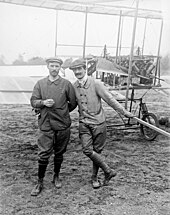
The FrenchmanAlphonse Pénaudfiled the first patent for a flying machine with a boat hull and retractable landing gear in 1876, but AustrianWilhelm Kressis credited with building the first seaplane,Drachenflieger,in 1898, although its two 30 hp (22 kW) Daimler engines were inadequate for take-off, and it later sank when one of its two floats collapsed.[7]
On 6 June 1905,Gabriel Voisintook off and landed on the RiverSeinewith a towed kite glider on floats. The first of his unpowered flights was 150 yards (140 m).[7]He later built a powered floatplane in partnership withLouis Blériot,but the machine was unsuccessful.
Other pioneers also attempted to attach floats to aircraft in Britain, Australia, France and the United States.
On 28 March 1910, FrenchmanHenri Fabreflew the first successful powered seaplane, theGnome Omega-poweredhydravion,a trimaranfloatplane.[8]Fabre's first successful take off and landing by a powered seaplane inspired other aviators, and he designed floats for several other flyers. The first hydro-aeroplane competition was held inMonacoin March 1912, featuring aircraft using floats from Fabre, Curtiss, Tellier and Farman. This led to the first scheduled seaplane passenger services, atAix-les-Bains,using a five-seat Sanchez-Besa from 1 August 1912.[7]TheFrench Navyordered its first floatplane in 1912. On May 10, 1912Glenn L. Martinflew a homemade seaplane inCalifornia,settingrecordsfor distance and time.[9]
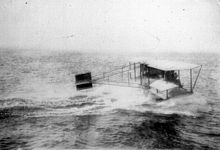
In 1911−12,François Denhautconstructed the first seaplane with a fuselage forming a hull, using various designs to givehydrodynamic liftat take-off. Its first successful flight was on 13 April 1912.[7] Throughout 1910 and 1911, American pioneering aviatorGlenn Curtissdeveloped his floatplane into the successfulCurtiss Model Dland-plane, which used a larger central float and sponsons. Combining floats with wheels, he made the first amphibian flights in February 1911 and was awarded the firstCollier Trophyfor US flight achievement. From 1912, his experiments with a hulled seaplane resulted in the 1913Model E and Model F,which he called "flying-boats".[7] In February 1911, theUnited States Navytook delivery of theCurtiss Model Eand soon tested landings on and take-offs from ships, using the Curtiss Model D.
There were experiments by aviators to adapt theWright Model Bto a water landing. The first motion picture recorded from an airplane was from a Wright Model B floatplane, byFrank Coffynin 1911. The Wright Brothers, widely celebrated for their breakthrough aircraft designs, were slower to develop a seaplane; Wilbur died in 1912, and the company was bogged down in lawsuits. However, by 1913, the Wright Brother company developed the Wright Model CH Flyer.[10]In 1913, the Wright company also came out withe Wright Model G Aerboat, which was a seaplane with an enclosed cabin (a first for the company);the chief engineer of this version wasGrover Loening.[11]
In Britain, Captain Edward Wakefield andOscar Gnosspeliusbegan to explore the feasibility of flight from water in 1908. They decided to make use ofWindermerein theLake District,England's largestlake.The latter's first attempts to fly attracted large crowds, though the aircraft failed to take off and required a re-design of the floats incorporating features from the boat hulls of the lake's motor boat racing club member Isaac Borwick. Meanwhile, Wakefield ordered a floatplane similar to the design of the 1910 Fabre Hydravion. By November 1911, both Gnosspelius and Wakefield had aircraft capable of flight from water and awaited suitable weather conditions. Gnosspelius's flight was short-lived, as the aircraft crashed into the lake. Wakefield's pilot, however, taking advantage of a light northerly wind, successfully took off and flew at a height of 50 feet (15 m) to Ferry Nab, where he made a wide turn and returned for a perfect landing on the lake's surface.
In Switzerland,Émile Taddéoliequipped theDufaux 4biplane with swimmers and successfully took off in 1912. A seaplane was used during theBalkan Warsin 1913, when a Greek "Astra Hydravion" did a reconnaissance of the Turkish fleet and dropped four bombs.[12][13]
Birth of an industry[edit]


In 1913, theDaily Mailnewspaperput up a £10,000 prizefor thefirst non-stop aerial crossing of the Atlantic,which was soon "enhanced by a further sum" from theWomen's Aerial League of Great Britain.
American businessmanRodman Wanamakerbecame determined that the prize should go to an American aircraft and commissioned theCurtiss Aeroplane and Motor Companyto design and build an aircraft capable of making the flight. Curtiss's development of theFlying Fishflying boat in 1913 brought him into contact withJohn Cyril Porte,a retiredRoyal NavyLieutenant, aircraft designer and test pilot who was to become an influential British aviation pioneer. Recognising that many of the early accidents were attributable to a poor understanding of handling while in contact with the water, the pair's efforts went into developing practical hull designs to make the transatlantic crossing possible.[14]
The two years before World War I's breakout also saw the privately produced pair ofBenoist XIVbiplane flying boats, designed byThomas W. Benoist,initiate the start of the first heavier-than-air airline service anywhere in the world, and the first airline service of any kind at all in the United States.[15][16]
At the same time, the British boat-building firmJ. Samuel WhiteofCoweson theIsle of Wightset up a new aircraft division and produced a flying boat in the United Kingdom. This was displayed at the London Air Show at Olympia in 1913.[17]In that same year, a collaboration between the S. E. Saunders boatyard ofEast Cowesand theSopwith Aviation Companyproduced the "Bat Boat", an aircraft with aconsutalaminated hull that could operate from land or on water, which today is called anamphibious aircraft.[17]The "Bat Boat" completed several landings on sea and on land and was duly awarded theMortimer Singer Prize.[17]It was the first all-British aeroplane capable of making six return flights over five miles within five hours.

In the US, Wanamaker's commission built on Glen Curtiss's previous development and experience with theCurtiss Model F[18]for the U.S. Navy, which rapidly resulted in theAmerica,designed under Porte's supervision following his study and rearrangement of the flight plan; the aircraft was a conventionalbiplanedesign with two-bay, unstaggered wings of unequal span with two pusherinline enginesmounted side-by-side above thefuselagein the interplane gap. Wingtip pontoons were attached directly below the lower wings near their tips. The design (later developed into theModel H) resembled Curtiss's earlier flying boats but was built considerably larger so it could carry enough fuel to cover 1,100 mi (1,800 km). The three crew members were accommodated in a fully enclosed cabin.
Trials of theAmericabegan 23 June 1914 with Porte also as Chief Test Pilot; testing soon revealed serious shortcomings in the design; it was under-powered, so the engines were replaced with more powerful tractor engines. There was also a tendency for the nose of the aircraft to try to submerge as engine power increased while taxiing on water. This phenomenon had not been encountered before, since Curtiss's earlier designs had not used such powerful engines nor large fuel/cargo loads and so were relatively more buoyant. In order to counteract this effect, Curtiss fittedfinsto the sides of the bow to add hydrodynamic lift, but soon replaced these withsponsons,a type of underwater pontoon mounted in pairs on either side of a hull. These sponsons (or their engineering equivalents) and the flared, notched hull would remain a prominent feature of flying-boat hull design in the decades to follow. With the problem resolved, preparations for the crossing resumed. While the craft was found to handle "heavily" on takeoff, and required rather longer take-off distances than expected, thefull moonon 5 August 1914 was selected for the trans-Atlantic flight; Porte was to pilot theAmericawithGeorge Hallettas co-pilot and mechanic.
World War I (1914-18)[edit]
Curtiss and Porte's plans were interrupted by the outbreak of World War I. Porte sailed for England on 4 August 1914 and rejoined the Navy as a member of theRoyal Naval Air Service.Appointed Squadron Commander ofRoyal Navy Air Station Hendon,he soon convinced the Admiralty of the potential of flying boats and was put in charge of thenaval air stationatFelixstowein 1915. Porte persuaded theAdmiraltyto commandeer (and later, purchase) theAmericaand a sister craft from Curtiss. This was followed by an order for 12 more similar aircraft, one Model H-2 and the remaining asModel H-4s.Four examples of the latter were assembled in the UK bySaunders.All of these were similar to the design of theAmericaand, indeed, were all referred to asAmericas in Royal Navy service. The engines, however, were changed from the under-powered 160 hp Curtiss engines to 250 hpRolls-Royce Falconengines. The initial batch was followed by an order for 50 more (totalling 64Americasoverall during the war).[14]Porte also acquired permission to modify and experiment with the Curtiss aircraft.
The Curtiss H-4s were soon found to have a number of problems; they were underpowered, their hulls were too weak for sustained operations, and they had poor handling characteristics when afloat or taking off.[19][20]One flying boat pilot, Major Theodore Douglas Hallam, wrote that they were "comic machines, weighing well under two tons; with two comic engines giving, when they functioned, 180 horsepower; and comic control, being nose heavy with engines on and tail heavy in a glide."[21]

At Felixstowe, Porte made advances in flying-boat design and developed a practical hull design with the distinctive "Felixstowe notch".[22] Porte's first design to be implemented in Felixstowe was theFelixstowe Porte Baby,a large, three-enginedbiplaneflying boat, powered by one central pusher and two outboard tractorRolls-Royce Eagleengines.
Porte modified an H-4 with a new hull whose improved hydrodynamic qualities made taxiing, take-off and landing much more practical and called it theFelixstowe F.1.
Porte's innovation of the "Felixstowe notch" enabled the craft to overcome suction from the water more quickly and break free for flight much more easily. This made operating the craft far safer and more reliable. The "notch" breakthrough would soon after evolve into a "step", with the rear section of the lower hull sharply recessed above the forward lower hull section, and that characteristic became a feature of both flying-boat hulls and seaplane floats. The resulting aircraft would be large enough to carry sufficient fuel to fly long distances and could berth alongside ships to take on more fuel.
Porte then designed a similar hull for the largerCurtiss H-12flying boat which, while larger and more capable than the H-4s, shared failings of a weak hull and poor water handling. The combination of the new Porte-designed hull, this time fitted with two steps, with the wings of the H-12 and a new tail, and powered by twoRolls-Royce Eagleengines, was named the Felixstowe F.2 and first flew in July 1916,[23]proving greatly superior to the Curtiss on which it was based. It was used as the basis for all future designs.[24]It entered production as the Felixstowe F.2A, being used as a patrol aircraft, with about 100 being completed by the end of World War I. Another seventy were built, and these were followed by two F.2c, which were built at Felixstowe.
In February 1917, the first prototype of theFelixstowe F.3was flown. It was larger and heavier than the F.2, giving it greater range and heavier bomb load, but poorer agility. Approximately 100 Felixstowe F.3s were produced before the end of the war.

TheFelixstowe F.5was intended to combine the good qualities of the F.2 and F.3, with the prototype first flying in May 1918. The prototype showed superior qualities to its predecessors but, to ease production, the production version was modified to make extensive use of components from the F.3, which resulted in lower performance than the F.2A or F.5.
Porte's final design at theSeaplane Experimental Stationwas the 123-foot-span five-enginedFelixstowe Furytriplane (also known as the "Porte Super-Baby" or "PSB" ).[25]
F.2, F.3, and F.5 flying boats were extensively employed by the Royal Navy for coastal patrols and to search for GermanU-boats. In 1918, they were towed on lighters towards the northern German ports to extend their range; on 4 June 1918, this resulted in three F.2As engaging in a dogfight with ten German seaplanes, shooting down two confirmed and four probables at no loss.[14]As a result of this action, British flying boats weredazzle-paintedto aid identification in combat.

TheCurtiss Aeroplane and Motor Companyindependently developed its designs into the small Model F, the larger Model K (several of which were sold to the Russian Naval Air Service), and the Model C for the U.S. Navy. Curtiss, among others, also built the Felixstowe F.5 as theCurtiss F5L,based on the final Porte hull designs and powered by AmericanLiberty engines.
Meanwhile, the pioneering flying-boat designs of François Denhaut had been steadily developed by theFranco-British AviationCompany into a range of practical craft. Smaller than the Felixstowes, several thousand FBAs served with almost all of the Allied forces as reconnaissance craft, patrolling the North Sea, Atlantic and Mediterranean Oceans.
In Italy, several seaplanes were developed, starting with the L series and progressing with the M series. TheMacchi M.5,in particular, was extremely manoeuvrable and agile and matched the land-based aircraft it had to fight. Two hundred forty-four were built in total. Towards the end of World War I, the aircraft were flown by Italian Navy Aviation, United States Navy and United States Marine Corps airmen. Ensign Charles Hammann won the first Medal of Honor awarded to a United States naval aviator in an M.5
The German aircraft manufacturing companyHansa-Brandenburgbuilt flying boats starting with the modelHansa-Brandenburg GWin 1916, and had a degree of military success with theirHansa-Brandenburg W.12two-seat floatplane fighter the following year, being the primary aircraft flown by Imperial Germany's maritime fighter ace,Friedrich Christiansen.TheAustro-HungarianfirmLohner-Werkebegan building flying boats, starting with theLohner Ein 1914 and the later (1915) widely copiedLohner L.
Between the wars[edit]

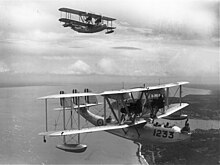
In September 1919, British companySupermarinestarted operating the first flying-boat service in the world, fromWoolstontoLe HavreinFrance,but it was short-lived.[citation needed]
A CurtissNC-4became the first airplane to fly across the Atlantic Ocean in 1919, crossing with multiple stops via theAzores.Of the four that made the attempt, only one completed the flight.
In 1923, the first successful commercial flying-boat service was introduced, with flights to and from theChannel Islands.After frequent appeals by the industry for subsidies, the Government decided that nationalization was necessary and ordered five aviation companies to merge to form the state-ownedImperial Airwaysof London (IAL). IAL became the internationalflag-carryingBritish airline, providing flying-boat passenger and mail-transport links between Britain andSouth AfricaandIndiausing aircraft such as theShort S.8 Calcutta.
In 1928, fourSupermarine Southamptonflying boats of theRAFFar East flight arrived inMelbourne,Australia.The flight was considered proof that flying boats had become a reliable means of long-distance transport.

In the 1930s, flying boats made it possible to have regular air transport between the U.S. and Europe, opening up new air travel routes to South America, Africa, and Asia.Foynes,IrelandandBotwood,Newfoundland and Labradorwere the terminals for many early transatlantic flights. In areas where there were no airfields for land-based aircraft, flying boats could stop at small river, lake or coastal stations to refuel and resupply. ThePan AmBoeing 314"Clipper" flying boats brought new exotic destinations like the Far East within reach and came to represent the romance of flight.
By 1931, mail from Australia was reaching Britain in 16 days, or less than half the time taken by sea. In that year, government tenders on both sides of the world invited applications to run new passenger and mail services between the ends of the Empire, andQantasand IAL were successful with a joint bid. A company under combined ownership was then formed, Qantas Empire Airways. The new ten-day service betweenRose Bay, New South Wales,(nearSydney) andSouthamptonwas such a success that the volume of mail soon exceeded aircraft storage space.
A solution was found by the British government, who had requestedShort Brothersto design a large long-range monoplane for IAL in 1933. Partner Qantas purchased sixShort Empireflying boats.

Delivering the mail as quickly as possible generated a lot of competition and some innovative designs. One variant of the Short Empire flying boats was the strange-lookingMaiaandMercury.It was a four-enginedfloatplaneMercury(the winged messenger) fixed on top ofMaia,a heavily modified Short Empire flying boat.[17]The larger Maia took off, carrying the smaller Mercury loaded to a weight greater than it could take off with. This allowed the Mercury to carry sufficient fuel for a direct trans-Atlantic flight with the mail. Unfortunately, this was too complex, and the Mercury had to be returned from America by ship. The Mercury did set some distance records beforein-flight refuellingwas adopted.
Sir Alan Cobhamdevised a method of in-flight refuelling in the 1930s. In the air, the Short Empire could be loaded with more fuel than it could take off with. Short Empire flying boats serving the trans-Atlantic crossing were refueled over Foynes; with the extra fuel load, they could make a direct trans-Atlantic flight.[17]AHandley Page H.P.54 Harrowwas used as the fuel tanker.[17]
The GermanDornier Do Xflying boat was noticeably different from its UK and U.S.-built counterparts. It had wing-like protrusions from the fuselage, calledsponsons,to stabilize it on the water without the need for wing-mounted outboard floats. This feature was pioneered byClaudius Dornierduring World War I on his Dornier Rs. I giant flying boat and perfected on theDornier Walin 1924. The enormous Do X was powered by 12 engines and carried 170 people.[17]It flew across the Atlantic to the Americas in 1929,[17]It was the largest flying boat of its time, but was severely underpowered and was limited by a very low operational ceiling. Only three were built, with a variety of engines installed, in an attempt to overcome the lack of power. Two of these were sold to Italy.

World War II[edit]

The military value of flying boats was well-recognized, and every country bordering on water operated them in a military capacity at the outbreak of the war. They were utilized in various tasks fromanti-submarinepatrol toair-sea rescueandgunfire spottingfor battleships. Aircraft such as thePBM Marinerpatrol bomber,PBY Catalina,Short Sunderland,andGrumman Gooserecovered downed airmen and operated as scout aircraft over the vast distances of thePacific TheaterandAtlantic.They also sank numerous submarines and found enemy ships. In May 1941, theGerman battleshipBismarckwas discovered by a PBY Catalina flying out ofCastle Archdale Flying boat base,Lower Lough Erne,Northern Ireland.[26][27]
The largest flying boat of the war was theBlohm & Voss BV 238,which was also the heaviest plane to fly during World War II and the largest aircraft built and flown by any of theAxis Powers.

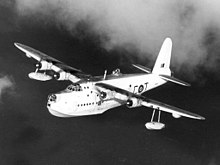
In November 1939, IAL was restructured into three separate companies:British European Airways,British Overseas Airways Corporation(BOAC), andBritish South American Airways(which merged with BOAC in 1949), with the change being made official on 1 April 1940. BOAC continued to operate flying-boat services from the (slightly) safer confines ofPoole Harbourduring wartime, returning toSouthamptonin 1947.[17]When Italy entered the war in June 1940, the Mediterranean was closed to Allied planes and BOAC andQantasoperated theHorseshoe Routebetween Durban and Sydney usingShort Empireflying boats.
The Martin Company produced the prototypeXPB2M Marsbased on their PBM Mariner patrol bomber, with flight tests between 1941 and 1943. The Mars was converted by the Navy into a transport aircraft designated the XPB2M-1R. Satisfied with the performance, twenty of the modified JRM-1 Mars were ordered. The first, namedHawaii Mars,was delivered in June 1945, but the Navy scaled back their order at the end of World War II, buying only the five aircraft which were then on the production line. The five Mars were completed, and the last delivered in 1947.[28]
Post-War[edit]

After World War II, the use of flying boats rapidly declined for several reasons. The ability to land on water became less of an advantage owing to the considerable increase in the number and length of land-based runways during World War II. Further, as the speed and range of land-based aircraft increased, the commercial competitiveness of flying boats diminished; their design compromised aerodynamic efficiency and speed to accomplish the feat of waterborne takeoff and landing. Competing with new civilian jet aircraft like thede Havilland CometandBoeing 707proved impossible.
TheHughes H-4 Hercules,in development in the U.S. during the war, was even larger than the BV 238, but it did not fly until 1947. The "Spruce Goose", as the 180-ton H-4 was nicknamed, was the largest flying boat ever to fly. Carried out during Senate hearings into Hughes's use of government funds on its construction, the short hop of about a mile (1.6 km) at 70 feet (21 m) above the water by the "Flying Lumberyard" was claimed by Hughes as vindication of his efforts. Cutbacks in expenditure after the war and the disappearance of its intended mission as a transatlantic transport left it no purpose.[29]
In 1944, theRoyal Air Forcebegan development of a small jet-powered flying boat that it intended to use as anair defenceaircraft optimised for the Pacific, where the relatively calm sea conditions around the many archipelagos made the use of seaplanes easier. By making the aircraft jet-powered, it was possible to design it with a hull rather than making it afloatplane.TheSaunders-Roe SR.A/1prototype first flew in 1947 and was relatively successful in terms of its performance and handling. However, by the end of the war, carrier-based aircraft were becoming more sophisticated, and the need for the SR.A/1 evaporated.
During theBerlin Airlift(which lasted from June 1948 until August 1949), tenSunderlandsand twoHytheswere used to transport goods fromFinkenwerderon theElbenearHamburgto isolated Berlin, landing on the Havelsee besideRAF Gatowuntil it iced over. The Sunderlands were particularly used for transporting salt, as their airframes were already protected against corrosion from seawater. Transporting salt in standard aircraft risked rapid and severe structural corrosion in the event of a spillage. In addition, threeAquilaflying boats were used during the airlift.[17]This is the only known operational use of flying boats within central Europe.
BOAC ceased flying boat services out of Southampton in November 1950.
Bucking the trend, in 1948,Aquila Airwayswas founded to serve destinations that were still inaccessible to land-based aircraft.[17]This company operatedShort S.25andShort S.45flying boats out of Southampton on routes toMadeira,Las Palmas,Lisbon,Jersey,Majorca,Marseille,Capri,Genoa,MontreuxandSanta Margherita.[17]From 1950 to 1957, Aquila also operated a service fromSouthamptontoEdinburghandGlasgow.[17]The flying boats of Aquila Airways were also chartered for one-off trips, usually to deploy troops where scheduled services did not exist or where there were political considerations. The longest charter, in 1952, was from Southampton to theFalkland Islands.[17]In 1953, the flying boats were chartered for troop-deployment trips toFreetownandLagos,and there was a special trip fromHulltoHelsinkito relocate a ship's crew.[17]The airline ceased operations on 30 September 1958.[17]

The technically advancedSaunders-Roe Princessfirst flew in 1952 and later received acertificate of airworthiness.Despite being the pinnacle of flying-boat development, none were sold, thoughAquila Airwaysreportedly attempted to buy them.[17]Of the threePrincessesthat were built, two never flew, and all were scrapped in 1967. In the late 1940s, Saunders-Roe also produced the jet-poweredSR.A/1flying-boat fighter, which did not progress beyond flying prototypes.
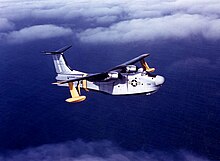
The U.S. Navy continued to operate flying boats (notably theMartin P5M Marlin) until the early 1970s. The Navy even built a jet-powered seaplane bomber, theMartin Seamaster.
The U.S. Coast Guard operatedHU-16 Albatross(affectionately known as the 'goat') well into the 1980s, retiring them as the airframes clocked out their flying 11 thousand flying hours. About twenty were still in service in the 1970s, and the last operation flight was in 1983. The aircraft was very popular with the Coast Guard due to its unique capabilities compared to other types, and was noted for its versatility, range, and ability to land on water which was especially useful for water rescues.[30]
Ansett Australiaoperated a flying-boat service from Rose Bay toLord Howe Islanduntil 1974, usingShort Sandringhams.
On 18 December 1990, Pilot Tom Casey completed the first round-the-world flight in a floatplane with only water landings using aCessna 206named Liberty II.[31]
Uses and operation[edit]


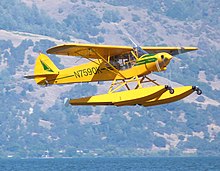
Many modern civilian aircraft have a floatplane variant, usually as utility transports to lakes and other remote areas. Most of these are offered as third-party modifications under asupplemental type certificate(STC), although there are several aircraft manufacturers that build floatplanes from scratch, and a few that continue to buildflying boats.Some older flying boats remain in service for firefighting duty, as well as theCanadair CL-415which remains in production as of 2022, andChalk's Ocean Airwaysoperated a fleet of Grumman Mallards in passenger service until service was suspended after acrashon December 19, 2005, which was linked to maintenance, not to design of the aircraft. Purely water-based seaplanes have largely been supplanted by amphibious aircraft. Seaplanes can only take off and land on water with little or nowaveaction and, like other aircraft, have trouble in extreme weather. The size of waves a given design can withstand depends on, among other factors, the aircraft's size, hull or float design, and its weight, all making for a much more unstable aircraft, limiting actual operational days. Flying boats can typically handle rougher water and are generally more stable than floatplanes while on the water.
Seaplanes are also used in remote areas such as theAlaskanandCanadianwilderness, especially in areas with a large number oflakesconvenient for takeoff and landing. They may operate on acharterbasis, provide scheduled service, or be operated by residents of the area for personal use. There are seaplane operators that offer services between islands such as in theCaribbean Seaor theMaldives.Usually these are converted from reliable commercial models, and fitted for floats.
One of the modern floatplane conversions under consideration in the 2020s, is floatplane version of the C-130 for special military applications.[32]
See also[edit]
- List of flying boats and floatplanes
- Ground effect vehicle
- IAR 111
- Observation seaplane
- Seaplane tender
References[edit]
- ^abcGunston, "The Cambridge Aerospace Dictionary", 2009.
- ^de Saint-Exupery, A. (1940). "Wind, Sand and Stars" p33, Harcourt, Brace & World, Inc.
- ^The Oxford English Dictionary defines "seaplane" as An aeroplane designed to be able to operate from water;specifically,one with floats, in contrast to a flying boat.
- ^"Definition of FLYING BOAT".merriam-webster.18 April 2023.
- ^"Definition of FLOATPLANE".merriam-webster.10 June 2023.
- ^"Definition of SEAPLANE".merriam-webster.3 June 2023.
- ^abcdeFlying Boats & Seaplanes: A History from 1905,Stéphane Nicolaou[page needed]
- ^Naughton, Russell.Henri Fabre (1882–1984). "Monash University Centre for Telecommunications and Information Engineering,May 15, 2002. Retrieved: 9 May 2008
- ^"CHL # 775 First water-to-water flight Orange".californiahistoricallandmarks.
- ^"Wright Brothers Flying Boats Part II".
- ^"1913-1914 Wright Model G".wright-brothers.org.Retrieved2023-12-20.
- ^"Anonymous (2009) The establishment of the Navy Airforce, Fox2 Magazine (in Greek language)".Archived fromthe originalon December 3, 2013.
- ^Stéphane Nicolaou (1998).Flying Boats & Seaplanes: A History from 1905.Devon: Bay Books View Ltd. p. 9.ISBN1901432203.
- ^abcThe Felixstowe Flying Boats,Flight2 December 1955
- ^Missouri Historical Society.Bulletin of the Missouri Historical Society, Volumes 31–32.
- ^"airandspacemuseum.org Roos, Frederick W.," The Brief, Bright Aviation Career of St. Louis's Tom Benoist, "American Institute of Aeronautics and Astronautics, Inc., 2005".Archived fromthe originalon December 21, 2010.
- ^abcdefghijklmnopqHull, Norman.Flying Boats of the Solent: A Portrait of a Golden Age of Air Travel(Aviation Heritage). Great Addington, Kettering, Northants, UK: Silver Link Publishing, 2002.ISBN1-85794-161-6.
- ^Carpenter, Jr, G. J. (Jack) (2005)."Photographs 1914".Glenn H. Curtiss, Founder of The American Aviation Industry.Internet Archive - Way Back Machine. Archived fromthe originalon October 20, 2006.Retrieved15 December2015.
- ^BruceFlight2 December 1955, p. 844.
- ^London 2003, pp. 16–17.
- ^Hallam 1919, pp. 21–22.
- ^"Felixstowe."Archived2006-09-01 at theWayback MachineNASM.Retrieved: May 20, 2012.
- ^London 2003, pp. 24–25.
- ^BruceFlight2 December 1955, p. 846.
- ^"Felixstowe Flying-Boats."Will Higgs Co, United Kingdom.Retrieved: 24 December 2009.
- ^"Flying-boats in Fermanagh".Inland Waterways News.Inland Waterways Association of Ireland. Spring 2002. Archived fromthe originalon 2012-07-20.Retrieved2012-05-20.
- ^"Castle Archdale Country Park".Northern Ireland Environment Agency. Archived fromthe originalon 2009-05-01.Retrieved2009-06-19.
- ^Goebel, Greg."The Martin Mariner, Mars, & Marlin Flying Boats."Vectorsite.Retrieved: May 20, 2012.
- ^Its claim to true flying status is disputed as it made but one short flight in its life
- ^"1951: Coast Guard Acquires the UF-1G/2G Albatross Aircraft".Coast Guard Aviation History.Retrieved2023-12-20.
- ^Bill Coleman (April 1991). "Floats over the world".Air Progress:42.
- ^Trevithick, Joseph (2023-05-09)."Amphibious C-130 Won't Fly For Two To Three More Years".The Drive.Retrieved2023-12-20.
External links[edit]
 Media related toSeaplanesat Wikimedia Commons
Media related toSeaplanesat Wikimedia Commons
